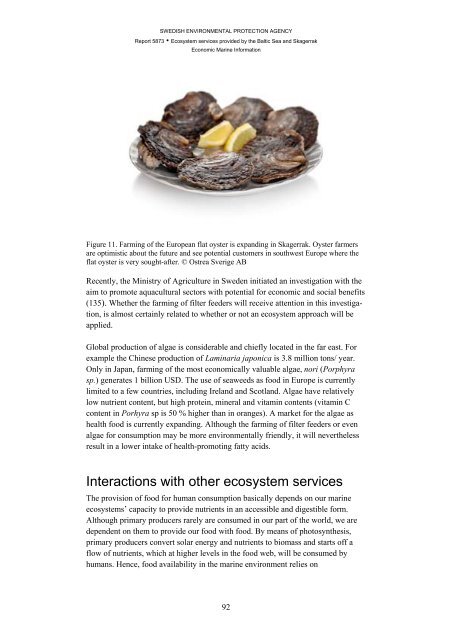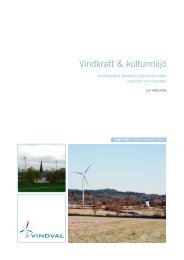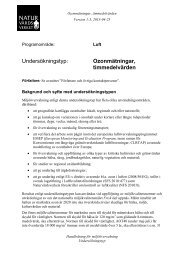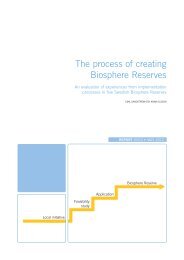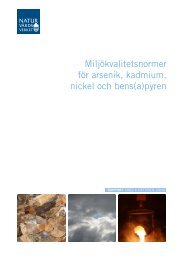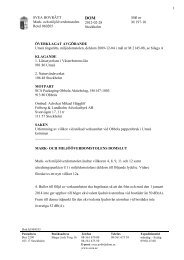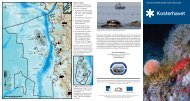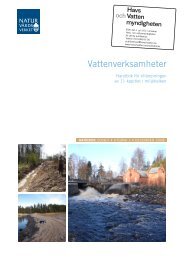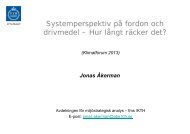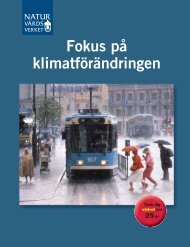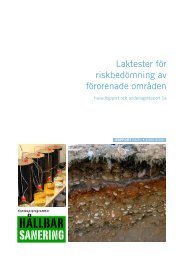Ecosystem services provided by the Baltic Sea ... - Naturvårdsverket
Ecosystem services provided by the Baltic Sea ... - Naturvårdsverket
Ecosystem services provided by the Baltic Sea ... - Naturvårdsverket
Create successful ePaper yourself
Turn your PDF publications into a flip-book with our unique Google optimized e-Paper software.
SWEDISH ENVIRONMENTAL PROTECTION AGENCY<br />
Report 5873 • <strong>Ecosystem</strong> <strong>services</strong> <strong>provided</strong> <strong>by</strong> <strong>the</strong> <strong>Baltic</strong> <strong>Sea</strong> and Skagerrak<br />
Economic Marine Information<br />
Figure 11. Farming of <strong>the</strong> European flat oyster is expanding in Skagerrak. Oyster farmers<br />
are optimistic about <strong>the</strong> future and see potential customers in southwest Europe where <strong>the</strong><br />
flat oyster is very sought-after. © Ostrea Sverige AB<br />
Recently, <strong>the</strong> Ministry of Agriculture in Sweden initiated an investigation with <strong>the</strong><br />
aim to promote aquacultural sectors with potential for economic and social benefits<br />
(135). Whe<strong>the</strong>r <strong>the</strong> farming of filter feeders will receive attention in this investigation,<br />
is almost certainly related to whe<strong>the</strong>r or not an ecosystem approach will be<br />
applied.<br />
Global production of algae is considerable and chiefly located in <strong>the</strong> far east. For<br />
example <strong>the</strong> Chinese production of Laminaria japonica is 3.8 million tons/ year.<br />
Only in Japan, farming of <strong>the</strong> most economically valuable algae, nori (Porphyra<br />
sp.) generates 1 billion USD. The use of seaweeds as food in Europe is currently<br />
limited to a few countries, including Ireland and Scotland. Algae have relatively<br />
low nutrient content, but high protein, mineral and vitamin contents (vitamin C<br />
content in Porhyra sp is 50 % higher than in oranges). A market for <strong>the</strong> algae as<br />
health food is currently expanding. Although <strong>the</strong> farming of filter feeders or even<br />
algae for consumption may be more environmentally friendly, it will never<strong>the</strong>less<br />
result in a lower intake of health-promoting fatty acids.<br />
Interactions with o<strong>the</strong>r ecosystem <strong>services</strong><br />
The provision of food for human consumption basically depends on our marine<br />
ecosystems’ capacity to provide nutrients in an accessible and digestible form.<br />
Although primary producers rarely are consumed in our part of <strong>the</strong> world, we are<br />
dependent on <strong>the</strong>m to provide our food with food. By means of photosyn<strong>the</strong>sis,<br />
primary producers convert solar energy and nutrients to biomass and starts off a<br />
flow of nutrients, which at higher levels in <strong>the</strong> food web, will be consumed <strong>by</strong><br />
humans. Hence, food availability in <strong>the</strong> marine environment relies on<br />
92


